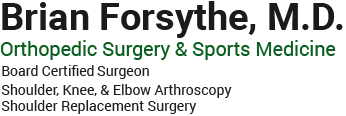Shoulder
Normal Anatomy of the Shoulder Joint
The shoulder is the most flexible joint in the body enabling a wide range of movements including: forward flexion, abduction, adduction, external rotation, internal rotation, and 360-degree circumduction.
Shoulder Instability
Shoulder instability is a chronic condition that causes frequent dislocations of the shoulder joint.
Rotator Cuff Tear
Rotator cuff is the group of tendons in the shoulder joint providing support and enabling wider range of motion. Major injury to these tendons may result in tear of these tendons and the condition is called as rotator cuff tear. It is one of the most common causes of shoulder pain in middle aged adults and older individuals.
Frozen Shoulder
Frozen shoulder, also called adhesive capsulitis is a condition characterized by pain and loss of motion in shoulder joint. It is more common in older adults aged between 40 and 60 years and is more common in women than men.
Shoulder Impingement
Shoulder impingement is the condition of inflammation of the tendons of the shoulder joint. It is one of the most common causes of pain in the adult shoulder. The shoulder is a 'ball-and-socket' joint. A ‘ball' at the top of the upper arm bone, humerus, fits neatly into a 'socket’, called the glenoid, which is part of the shoulder blade, scapula.
Clavicle Fracture
Clavicle fracture, also called broken collarbone is a very common sports injury seen in people who are involved in contact sports such as football and martial arts as well as impact sports such as motor racing. A direct blow over the shoulder that may occur during a fall on an outstretched arm or a motor vehicle accident may cause the clavicle bone to break. Broken clavicle may cause difficulty in lifting your arm because of pain, swelling and bruising over the bone.
Shoulder Arthroscopy
Arthroscopy is a minimally invasive diagnostic and surgical procedure performed for joint problems. Shoulder arthroscopy is performed using a pencil-sized instrument called an Arthroscope. The arthroscope consists of a light system and camera to project images to a computer screen for your surgeon to view the surgical site.
Shoulder Joint Replacement
The shoulder is a highly movable body joint that allows various movements of the arm. It is a ball and socket joint, where the head of the humerus (upper arm bone) articulates with the socket of the scapula (shoulder blade) called the glenoid. The two articulating surfaces of the bones are covered with cartilage, which prevents friction between the moving bones. The cartilage is lubricated by synovial fluid. Tendons and ligaments around the shoulder joint provide strength and stability to the joint.
Click on the topics below to find out more from the orthopedic connection website of American Academy of Orthopaedic Surgeons.
- The Shoulder
- Arthritis of the Shoulder
- Broken Collarbone
- Dislocated Shoulder
- Fracture of the shoulder blade (scapula)
- Frozen Shoulder
- Rotator Cuff Tears
- Separated Shoulder
- Shoulder Impingement (Bursitis, Tendinitis)
- Shoulder Joint Replacement
- Shoulder Joint Tear (Glenoid Labrum Tear)
- Thoracic outlet syndrome
- Shoulder Arthroscopy















